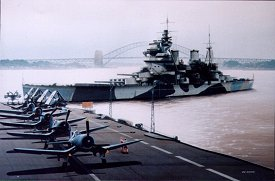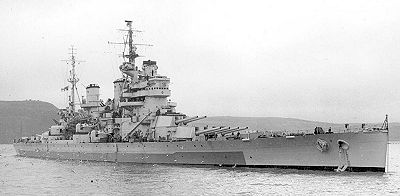HMS Anson King George V Class Battleship
Overview
The design of the King George V class of battleships began in a period of uncertainty, when the inter-war naval treaties were coming to an end but there was no clear direction to the future of global naval arms limitation. Great Britain was pushing to limit the calibre of main guns to 14.0 in (356 mm),while other nations had their own agendas. Discussions over a new naval treaty to replace those that would lapse at the end of 1936 dragged on through the mid-1930s.The limiting step in capital ship construction time was the production of main guns, including the mountings and turrets, which itself had to be preceded by outline ship design work. While the Admiralty would have preferred to wait for a new treaty to have been finalised, it needed to place gun contracts for its new battleships before the talks had concluded in order to get them in service in 1940 (to match the Bismarck and Tirpitz). This deadline, and to keep them within Great Britain’s own policies on gun calibre and existing treaty limits on tonnage during the talks, profoundly influenced the ship’s design.
In mid-1936, while talks proceeded, the designers opted for 14.0-inch (356-mm) main guns, in line with the British diplomatic moves intended to limit all new capital ships to that calibre. The class was initially intended to carry 12 guns, but designers decided to thicken the armour surrounding the magazines and in order to remain within the 35,000-long-ton (35,561-tonne) treaty limitations, B turret was reduced from four to two guns. When, in late 1936, naval treaty negotiations were abandoned without result, the Admiralty considered the six or 12-month delay entailed in upgrading the design grossly unacceptable and kept the original design.
The British followed the French example of fitting dual HA/LA (high angle/low angle) secondary guns instead of the traditional separate secondary guns for surface targets and smaller tertiary guns for air targets, as the Germans and Italians were doing. This had the advantage of employing more guns for either air defence or surface defence, provided that both were not required at the same time. The British installed a new 5.25-in (133-mm) gun, fitting 16 into eight power-operated turrets (four on each side).
Close-range anti-aircraft defence was light, in common with most ships at that time. The eight-barrelled pom-pom was chosen as the primary close-range weapon, and six were fitted to the first two ships in the class. This was increased to eight in subsequent vessels. Several unrifled projector (UP) rocket mounts, which fired an explosive charge attached to a parachute and a line, were fitted in the first two ships but these were so clearly useless that subsequent ships replaced them with 20-mm (0.79-in) machineguns. The anti-aircraft armament increased considerably as the war progressed.
Armour protection gave the ships a theoretical immunity zone of 17,200 to 32,000 yd (15,700 to 29,300 m) against 15.0-in (381-mm) shells, meaning that at ranges below 17,200 yd a shell that size could be expected to penetrate the side armour, and above 32,000 yd it could be expected to penetrate the deck armour. It must be stressed that this is theory only, as in practice several factors (particularly the sea state) affect the actual resistance to shells at the instant they hit, and the immunity zone is constantly changing as the ship heaves, rolls, and pitches.
The British place great emphasis on the need for speed in these ships, as existing Royal Navy battleships could not hope to catch new capital ships. The class was designed to reach 27.5 kt (51 km/h) at deep load displacement, an increase of 6.5 kt (12 km/h) over the previous class of British battleship. A catapult and two hangars served a pair of Supermarine Walrus amphibious biplanes used in a reconnaissance role and to spot the fall of shot. As radar became able to fulfil these roles, the aircraft were removed, eliminating a major fire hazard.
These ships gave magnificent service, and had a profound influence on the war. The Prince of Wales inflicted the damage that caused the Bismarck to abort her first and only sortie and the King George V helped destroy that German ship in the final engagement. Elsewhere, damage inflicted by the Duke of York forced the Scharnhorst to slow and be caught. The class achieved such success despite an unacceptable number of stoppages in the newly designed main guns and a flawed bow design that let spray interfere with the A and B turret range-finders and sometimes let water into A turret. These problems derived from the design process and were exacerbated by the Royal Navy’s delicate strategic position; difficulties with the guns were identified during design but could not be fixed due to Great Britain’s urgent need to counter the new German capital ships. In the final analysis, the King George V class ships were able to fulfil their defined roles despite their shortcomings and proved equal to the task of containing the enemy surface threat.
The Anson was built by Swan Hunter. She was laid down on 22.07.1937, launched on 24.02.1940 and completed 22.06.1942. She was the only one of the class never to fire her main guns in anger. She saw service covering Arctic convoys until June 1944, when she was sent to Plymouth for modification. In April 1945, she and the Duke of York sailed to join the British Pacific Fleet, although they arrived too late to see any action.

